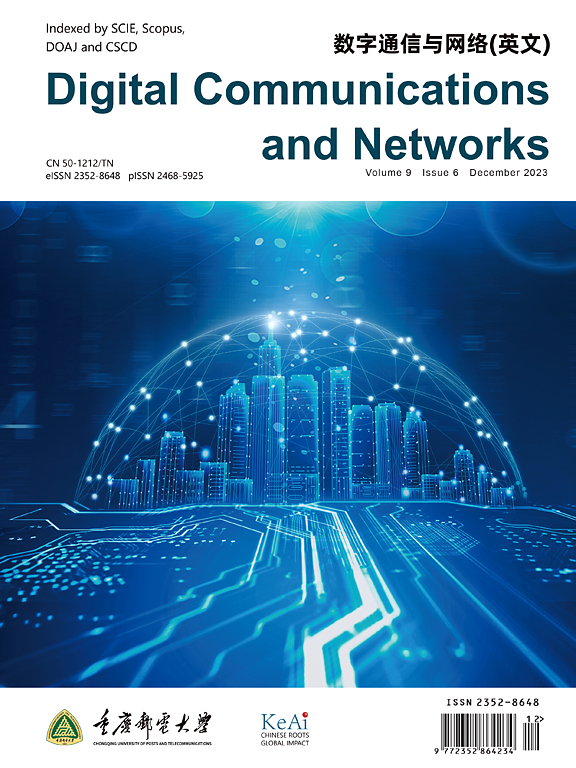MIMO方案的异构射频/水下光无线通信中继系统
IF 7.5
2区 计算机科学
Q1 TELECOMMUNICATIONS
引用次数: 0
摘要
本文研究了多输入多输出射频/水下光无线通信(MIMO-RF/UOWC)框架下的协同中继传输系统,旨在建立海基异构网络。在这种情况下,射频链路服从κ-μ衰落,而UOWC链路则服从广义伽玛衰落,并伴有指向误差损害。继电器在放大和转发(AF)协议下工作。此外,在UOWC链路中考虑了由吸收和散射(AaS)引起的衰减。这项工作得到了平均信道容量(ACC)、中断概率(OP)和平均误码率(BER)的精确结果。此外,为了揭示更深入的见解,推导了ACC的界以及OP和平均BER的渐近结果。研究结果强调了MIMO-RF/UOWC AF系统与单输入-单输出(SISO)-RF/UOWC AF系统相比的优越性能。影响MIMO-RF/UOWC自动对焦系统分集增益(DG)的因素包括天线数量/孔径、链路衰落参数和指向误差参数。此外,虽然AaS效应的增加会导致显著的衰减,但它并不能决定所提出的MIMO-RF/UOWC AF中继系统的可实现DG。本文章由计算机程序翻译,如有差异,请以英文原文为准。
Heterogeneous radio frequency/underwater optical wireless communication relaying systems with MIMO scheme
This paper studies a cooperative relay transmission system within the framework of Multiple-Input Multiple-Output Radio Frequency/Underwater Optical Wireless Communication (MIMO-RF/UOWC), aiming to establish sea-based heterogeneous networks. In this setup, the RF links obey κ-μ fading, while the UOWC links undergo the generalized Gamma fading with the pointing error impairments. The relay operates under an Amplify-and-Forward (AF) protocol. Additionally, the attenuation caused by the Absorption and Scattering (AaS) is considered in UOWC links. The work yields precise results for the Average Channel Capacity (ACC), Outage Probability (OP), and average Bit Error Rate (BER). Furthermore, to reveal deeper insights, bounds on the ACC and asymptotic results for the OP and average BER are derived. The findings highlight the superior performance of MIMO-RF/UOWC AF systems compared to Single-Input-Single-Output (SISO)-RF/UOWC AF systems. Various factors affecting the Diversity Gain (DG) of the MIMO-RF/UOWC AF system include the number of antennas/apertures, fading parameters of both links, and pointing error parameters. Moreover, while an increase in the AaS effect can result in significant attenuation, it does not determine the achievable DG of the proposed MIMO-RF/UOWC AF relaying system.
求助全文
通过发布文献求助,成功后即可免费获取论文全文。
去求助
来源期刊

Digital Communications and Networks
Computer Science-Hardware and Architecture
CiteScore
12.80
自引率
5.10%
发文量
915
审稿时长
30 weeks
期刊介绍:
Digital Communications and Networks is a prestigious journal that emphasizes on communication systems and networks. We publish only top-notch original articles and authoritative reviews, which undergo rigorous peer-review. We are proud to announce that all our articles are fully Open Access and can be accessed on ScienceDirect. Our journal is recognized and indexed by eminent databases such as the Science Citation Index Expanded (SCIE) and Scopus.
In addition to regular articles, we may also consider exceptional conference papers that have been significantly expanded. Furthermore, we periodically release special issues that focus on specific aspects of the field.
In conclusion, Digital Communications and Networks is a leading journal that guarantees exceptional quality and accessibility for researchers and scholars in the field of communication systems and networks.
 求助内容:
求助内容: 应助结果提醒方式:
应助结果提醒方式:


